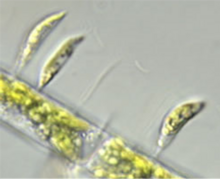|
Characium
Characium is a genus of green algae in the family Characiaceae.[1] It is very commonly found in freshwater habitats, where it is attached to phytoplankton or zooplankton.[2] DescriptionCharacium consists of single or rarely clustered cells. They are attached to a plant or animal substrate (thus epiphytic or epizoic), via a stalk or a circular pad. The cells have diverse shapes, ranging from fusiform to club-shaped or spherical, and are variously straight, hooked, or S-shaped. Cells usually contain a single parietal chloroplast filling the cell, with a central pyrenoid. In some species, the chloroplasts fragment into multiple plastids, each with one pyrenoid.[3] Mature cells have one nucleus (are uninucleate).[4] Characium reproduces asexually by zoospores. Zoospores have two flagella.[3] IdentificationThe genus Characium is similar to Characiopsis, a type of algae in the class Eustigmatophyceae. The two genera are very similar and have been confused in the past;[5] however, Characium produces starch to store excess carbon and thus stains brown to purple in Lugol's iodine solution, while Characiopsis does not.[6] Many other similar segregate genera have been named. These include Deuterocharacium, which differs in having chloroplasts without pyrenoids,[7] and Characiopodium, with multinucleate mature cells.[4] Identification of species depends on the shapes and sizes of the cell body, as well as the stipe with which the body is attached.[1] Species list
References
|
||||||||||||||||||||||||||||
